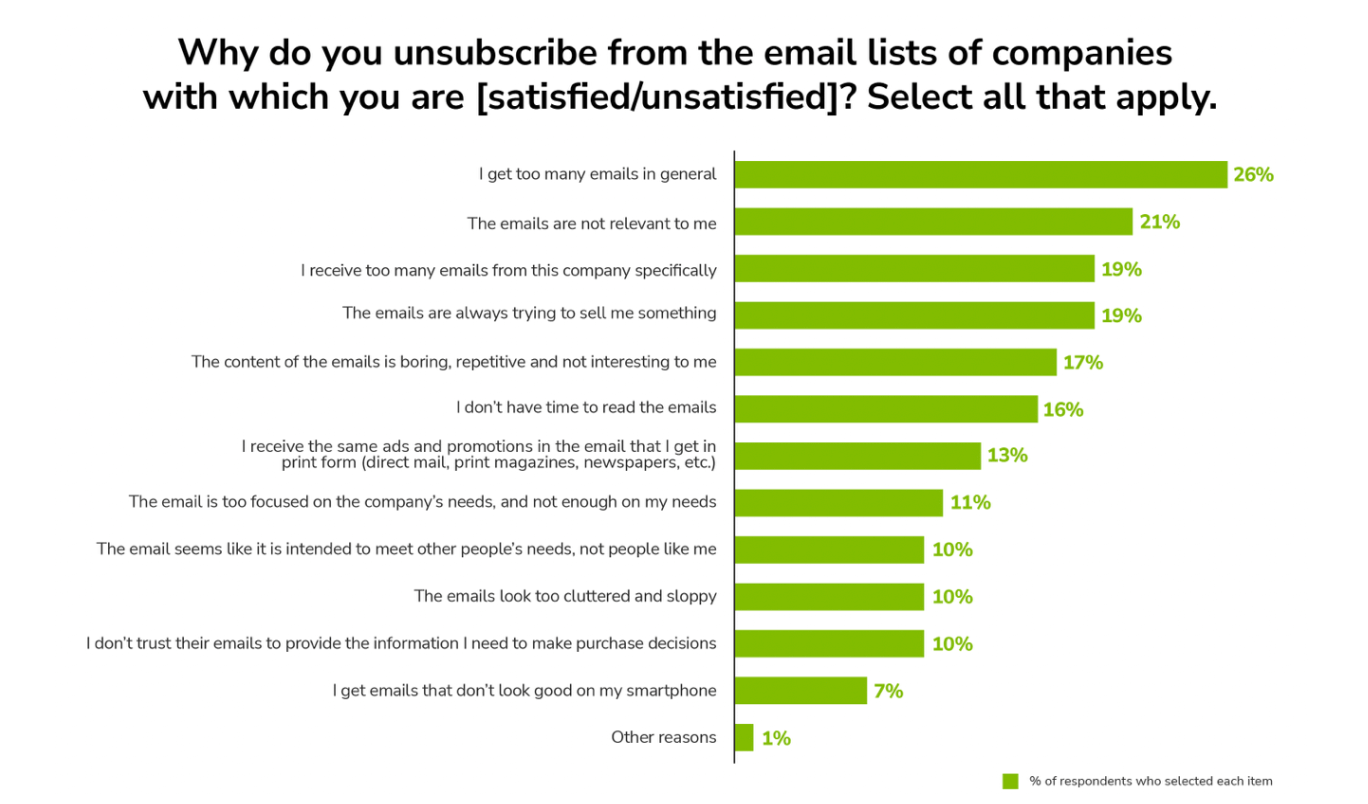It's frustrating when leads unsubscribe from your email list. Not only do you lose the potential business, but you also lose the opportunity to continue nurturing that relationship. Why do people unsubscribe from email lists?
*Updated 8/7/2024
It's never a fun experience to see people unsubscribe from your email list, but it's important to remember that it's not always their fault. In many cases, subscribers may unsubscribe because they don't feel like they're getting anything valuable from your email.
In this article, we'll discuss how to get subscribers back on board and generate more leads for your business!
5 Reasons Leads Unsubscribe From Your Email List
1. Email Content is Irrelevant
If your email content isn't relevant to your subscribers, there's a good chance they'll unsubscribe. That's why it's important to segment your email list so you can send targeted content that each subscriber will find relevant.
You can segment your list in many ways, including location, age, gender, interests, etc.
By taking the time to segment your list, you'll be able to send emails that are more likely to be opened and read, which will keep your subscribers happy. For this reason email nurturing is important.
 (Image Source: Leadbridge)
(Image Source: Leadbridge)
2. Subscribers Want to Be Educated Not Sold
Nobody likes to be blatantly sold to, primarily through email. If you're bombarding your subscribers with sales pitches, it's no wonder they unsubscribe.
Instead of selling, focus on providing value to your subscribers. Share helpful tips, interesting articles, and relevant blog posts. Focus on delivering value; you'll be much more likely to keep your subscribers engaged — and subscribed to your email list.
Irrelevant and sales-centric emails will most likely end up in a subscriber's spam folder. Make sure the emails you are sending go to your lead's main inbox and not their spam folder. This will ensure you maintain a good domain reputation and review different email deliverability mistakes.
 (Image Source: Unsplash)
(Image Source: Unsplash)
3. Unaware They Had Subscribed
In some cases, subscribers may unsubscribe because they didn't realize they had subscribed in the first place. If you're not using a double opt-in process (when someone must confirm their email address before being added to your mailing list), this can sometimes happen.
To avoid having subscribers leave because they're unaware they had subscribed to begin with, be sure to send a welcome email as soon as someone opts-in. Thank the subscriber in your welcome email and explain to them what they can expect from your email content.
4. Flooded with Emails
Too many emails in an inbox can be overwhelming. If your subscribers feel like they're being bombarded with emails from you, they may unsubscribe. To avoid this, take a look at your email frequency and make sure you're not sending too many emails.
You may also want to consider giving subscribers the option to choose how often they receive emails from you. This way, they can choose to receive an email every day, once a week, or even just once a month.
Allowing your email subscribers to customize the frequency of emails can help to keep them on your list longer.
 (Image Source: Randall Reilly)
(Image Source: Randall Reilly)
5. Emails Are Poorly Optimized for All Devices
In today's world, it's crucial to optimize your email content for all devices. With so many people reading email on their smartphones and tablets, your email must look good on all devices.
If your email isn't optimized for mobile, customers will get frustrated and unsubscribe because they don’t feel served by your email outreach. Emails need to be responsive in design, and all links should be clickable on mobile devices.
How to Get Subscribers Back After Unsubscribing
-
Re-Engagement Campaign
The first step to getting subscribers back is to launch a re-engagement campaign. This is a campaign specifically designed to reach out to email subscribers who have gone inactive.
Your re-engagement campaign should include email content that's relevant and engaging, with a strong call-to-action. You may also want to offer a discount or incentive for subscribers who reactivate their subscription.
(Image Source: Marketing Charts)
Take the time to master your email subject line in your re-engagement campaign. You need them to open this email to have any hope of winning them back.
Email subjects are one of the key elements to re-engage leads and get them to open your emails. Once that's been achieved, it's up to your copy or enticing offer to get them back on your side.
-
Remind Them of Your Value
In your re-engagement email, it's important to remind subscribers of your value. Why should they stay subscribed to your email list? What can they expect to gain from receiving your email content?
If you're sending out an email to people who have subscribed to your mailing list, it's a good idea to highlight any new features or changes that have been made since they last received an email from you.
Try sending a relevant, attention-grabbing blog post that is recently written to spark the interest of those subscribed to your emails. If you need help creating a post, turn to a content writing service that will produce high-quality content and allow you to focus on other areas of engagement.
(Image Source: Hubspot)
This can help show them that you're constantly evolving and improving and that there's always something new to look forward to. For example, if you've recently launched a new product or updated your website, mention it in your email.
If it's a feature that would be of interest to your email list, chances are former subscribers will want to know about it as well. This gives them another chance to evaluate the relationship and see if it's worth signing up again.
-
Offer Something in Return for Their Subscription
Offer something of value to customers for reactivating their subscription. This could be in the form of a discount on products or services or access to exclusive content that they would otherwise not have.
Doing this shows that you are willing to work with the customer and are interested in keeping them as a subscriber.
“We provided our customers with an extra month of our product subscription as a thank you gift for reactivation. This helped us bring a lot of dead leads to life again”. - Saurabh Wani, Marketing at ZoomShift.
This can often be the difference between a customer who reactivates their subscription and one who does not. With so many businesses competing for attention, your marketing needs to stand out from the crowd and offer something that your customers will find valuable.
Conclusion
People unsubscribe from email lists every day; an inbox is a very precious thing. Companies that are given permission to contact a customer in this manner have a responsibility to make sure that their email content is valuable, relevant, and not too frequent.
POWR has over 70 plugins available to help you boost conversations and capture and keep email subscribers. For example, the popup app can help you recover 21% of abandoned carts, or create a popup with an email subscription button which can help increase your conversions.
When someone unsubscribes, it can be tempting to email them and try to win them back, but this should be done respectfully and non-intrusively. If someone genuinely is uninterested in your product, they're not a good lead. Keep focusing on the good leads and use email to nurture them down the sales funnel.
Author Bio
Kelly Moser is the co-founder and editor at Home & Jet, a digital magazine for the modern era and content manager at Login Lockdown. She's also an expert in freelance writing and content marketing for SaaS, Fintech, and ecommerce startups.



